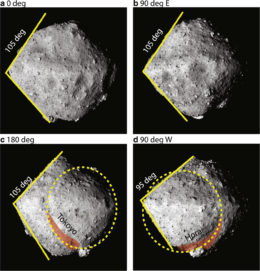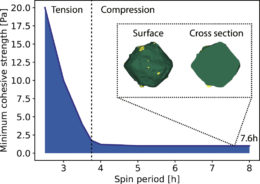Recent space missions have served as solar-system paparazzi, stalking a number of near-Earth objects — and the images they’ve sent home give us plenty to ponder. Can we use these observations to determine how one of these photogenic asteroids obtained its shape?
Visits to Asteroids

Asteroids Ryugu (top) and Bennu (bottom) have similar spinning-top shapes. Click to enlarge. [JAXA/U. of Tokyo/Kochi U./Rikkyo U./Nagoya U./Chiba Ins. Tech/Meiji U./U. Aizu/AIST; GSFC/NASA/U. of Arizona]
Both missions plan to eventually return samples of their targets to Earth to help us better understand asteroid composition. In the meantime, the spacecraft have provided stunning images of the asteroids’ surfaces and overall structures, allowing us to learn more about these kilometer-scale inhabitants of our solar system.
Details of a Spinning Top
One striking feature of these asteroids is their shape: both Bennu and Ryugu have so-called “spinning-top” shapes, characterized by a raised equatorial ridge that makes the asteroids look more diamond-like than circular when viewed from the side. Such a shape could conceivably be caused by the flow of materials to the equator, but this requires rapid rotation — quicker than Ryugu’s 7.6-hour or Bennu’s 4.3-hour periods.

Ryugu seen from the Hayabusa2 spacecraft from different angles. The western region exhibits a smoother surface and a sharper ridge angle than the rest of the asteroid. [Hirabayashi et al. 2019 via JAXA/U. of Tokyo/Kochi U./Rikkyo U./Nagoya U./Chiba Ins. Tech/Meiji U./U. Aizu/AIST]
Failed Structure?
Hirabayashi and collaborators use numerical models derived from Hayabusa2’s observations to analyze Ryugu’s current structure, judging how well different regions of the asteroid would hold up at different spin rates. The authors show that the subsurface region of the western bulge is currently structurally intact, whereas other regions are sensitive to structural failure. This suggests that the western bulge’s subsurface is relaxed — likely because it already experienced structural deformation in the past.

“Failure mode diagram” computed for Ryugu. The shaded region indicates combinations for which Ryugu cannot structurally exist because the cohesive strength of its material would be below that necessary to remain structurally intact at a given spin period. [Hirabayashi et al. 2019]
The authors acknowledge that this scenario is not the only possible explanation for Ryugu’s shape, but it’s a model that produces results consistent with Hayabusa2’s detailed images. As we gain more data from Hayabusa2 — and from OSIRIS-REx at Bennu — we can hope to refine our theories further!
Citation
“The Western Bulge of 162173 Ryugu Formed as a Result of a Rotationally Driven Deformation Process,” Masatoshi Hirabayashi et al 2019 ApJL 874 L10. doi:10.3847/2041-8213/ab0e8b

18 Comments
Pingback: AAS Nova – New
Pingback: Allgemeines Live-Blog vom 26. 3. bis 3. 4. 2019 | Skyweek Zwei Punkt Null
Pingback: NASA's New View of Asteroid Bennu Transports Us Far Away From Our Troubles - NewsEdgePoint
Pingback: NASA's New View Of Asteroid Bennu Transports Us Far Away From Our Troubles | Gizmodo Australia
Pingback: NASAs New View of Asteroid Bennu Transports Us Far Away From Our Troubles – Gizmodo – Dbm2News
Pingback: NASA’s New View of Asteroid Bennu Transports Us Far Away From Our Troubles – Gizmodo | Trending News Blog
Pingback: NASA’s New View of Asteroid Bennu Transports Us Far Away From Our Troubles – Gizmodo – News NMN and Co
Pingback: NASA’s New View of Asteroid Bennu Transports Us Far Away From Our Troubles | CHOCHILINO
Pingback: NASA’s New View of Asteroid Bennu Transports Us Far Away From Our Troubles – Gizmodo – btcTip.me
Pingback: NASA's New View of Asteroid Bennu Transports Us Far Away From Our Troubles - Gizmodo - Newark Now
Pingback: NASA's New View of Asteroid Bennu Transports Us Far Away From Our Troubles – Gizmodo | News
Pingback: NASA’s New View of Asteroid Bennu Transports Us Far Away From Our Troubles – iDesktop Web
Pingback: NASA’s New View of Asteroid Bennu Transports Us Far Away From Our Troubles – Sportscool Sports_Magazine
Pingback: Technonews18.com - Latest Tech News, New Gadgets news
Pingback: La nueva visión de la NASA del asteroide Bennu nos transporta lejos de nuestros problemas – Nota Global
Pingback: NASA’s New View of Asteroid Bennu Transports Us Far Away From Our Troubles – My Blog
Pingback: NASA captura imagens em alta resolução da superfície do asteroide Bennu – Curiosidade e Tecnologia
Pingback: NASA captura imagens em alta resolução da superfície do asteroide Bennu - Todo Tipo de Dica